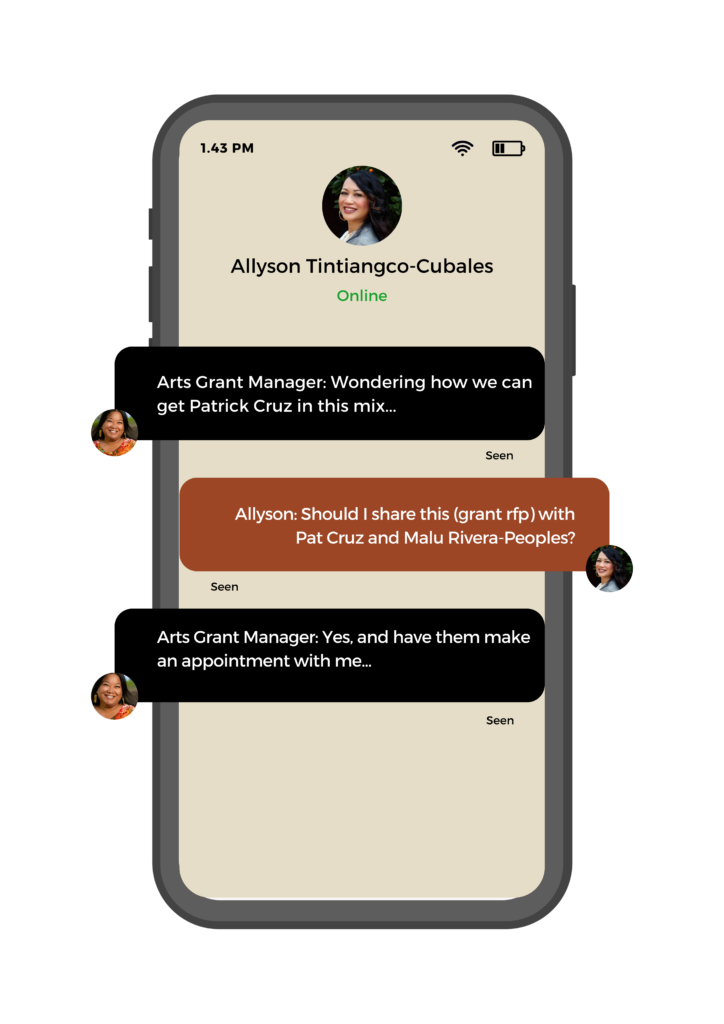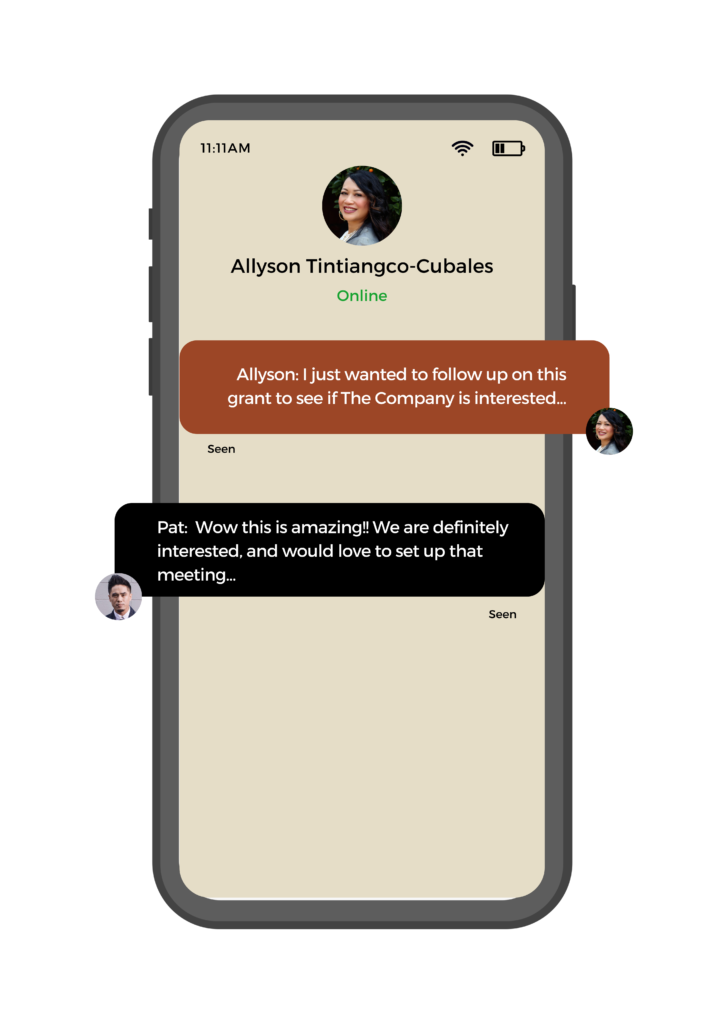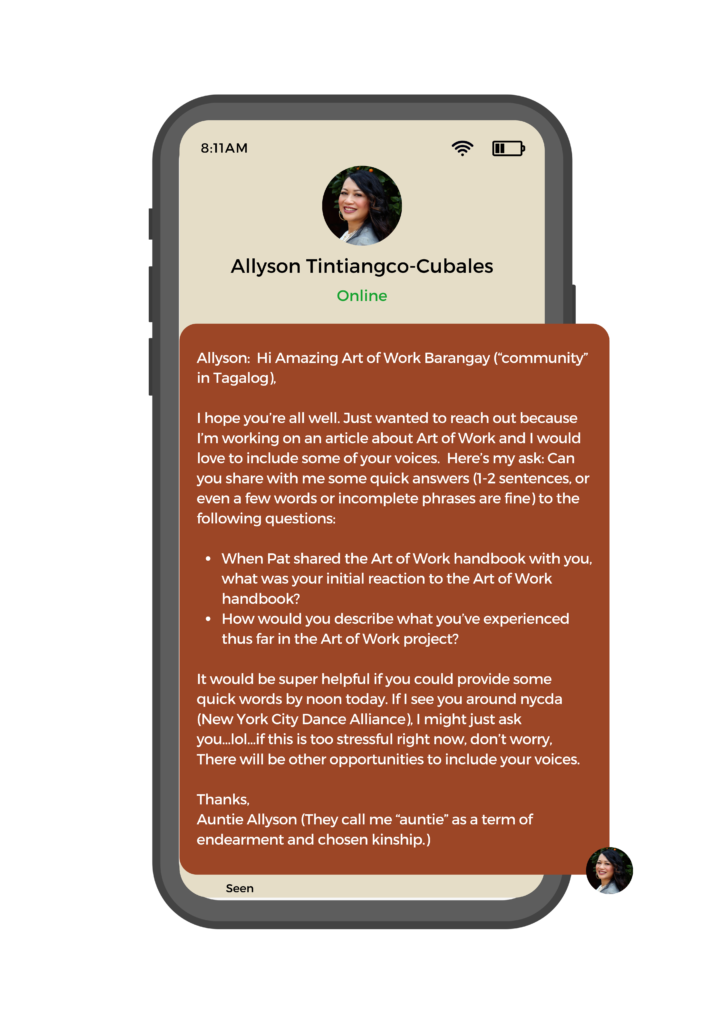The Art of Work[book]: Power of Text[ing] to Inspire Movement
Patrick Cruz
Allyson Tintiangco-Cubales
Arlene Daus-Magbual
Roderick Daus-Magbual
It started with a text. An impromptu text.
It was April 2021, a year into shelter-in-place, most communication outside of our bubbles were regulated to the digital world. Texting, which has become more common than even a phone call itself, served as an accessible and acceptable means to communicate. It is often seen as a way to relay quick simple ideas and get quick simple responses and unlike Zoom, which is meant to be an alternative to in-person interactions, we don’t expect texting to replace reality, it has its own purpose, technique, pedagogy, and choreography. And regardless of how we, as a society, tend to underestimate the power of texting, almost all of us can provide evidence and examples to attest how texts have changed our lives.
This all started with that impromptu text.
And then a sequence of steps began.
That is choreography, a sequence of steps. For this project, the sequence of steps that began with a text thread now tells a story. This is the power of text. Texting is pedagogical. More than pedagogy as instruction, pedagogy as the art of teaching and learning, texting as pedagogy has an accessible technique. The pedagogy of texting in some ways mimics the classroom which can either be oppressive or liberatory. Depending on a “teacher’s” or “texter’s” purpose, their vision manifests in how they engage their students/respondents and the students’/respondents’ context. The teacher’s/texter’s purpose greatly impacts the content and method in which they teach/text. In liberatory education, the roles of teacher and student are less hierarchical and more of a circular exchange. Similarly, text has the power to be authoritative and instructive and on the contrary, texting can be or become a radical space of possibility where those texting back and forth–regardless of role or positionality–have the power to initiate dialogue, respond, engage, and even disengage if desired. This type of texting technique allows us to test and practice our ideas prior to a “real” performance like Zoom or voice calls, and can even prepare us for interactions IRL (in real life). Texting is work, effort that leads to a product or production of some sorts. In this project, the power of text[ing] and also text in the form of a workbook inspired movement of profound choreography. But this choreography didn’t begin in a studio or in a class, nor was it part of a show or recital, the story began with an opportunity, an invitation, an offering, and then we were dancing. The cha cha of ideas created its own music and organically transformed into a process that was in itself a work of art…then Art of Work was born.
Opportunity

Texting can open a door to an unimagiable world of opportunities and resources. From a text to a Zoom meeting to writing our first grant, it resulted in the Gerbode Foundation to support its first Filipino hip hop choreographer ever. This San Francisco Bay Area foundation that “funds courageous leaders and visionary artists who make a positive impact in their communities and inspire others to change the world,” is known to support the artists but Filipinos in hip hop had never been funded by them till the Art of Work project. Despite the 50+ year long history of Filipinos in hip hop in the Bay Area, there are still legitimacy issues imposed on the art forms/elements of hip hop while also contentions around the place and positionality of Filipinos in hip hop culture. It is profound how one text had the potential to disrupt the hegemonic dialogue that occurs around art, performance, and race.
This shows the power and immediacy of a text to initiate action. But texts, just like lesson plans, are only as strong as the relationships that are built prior to the execution. It was the trust and love between Olivia, the grants manager and Allyson in their almost three-decade-long friendship/sisterhood that allowed for the texts to go rapidly from an inquiry to an opportunity. The relationships then extend to the text invitation to Malu Rivera-Peoples who has been long-time dance teacher and mentor of Allyson’s daughter, Mahalaya at the Westlake School for the Performing Arts (WSPA), and also Pat Cruz, Malu’s son, and the founder and director of the Company, the hip hop dance crew at WSPA.
Invitation

From the cha cha to the kid-n-play, each move is contingent on a partner. Texting is not necessarily dialectic but rather dialogic and when rooted in humanization and love, what may seem simple, can hold great power. When provided the invitation, Pat showed humble gratitude. This quick invitation turned into a series of Zoom meetings to talk through our brainstorms with about 100 hours of asynchronous volunteer writing and designing between Allyson and Pat to complete the grant application. What we created was beyond what we could have ever dreamed of.
Although we were new at arts grant writing, we created this as a unique project based on our epistemologies of living the work. The dialogue between Pat’s craft and practice, his philosophy and process, his purpose and intentions and Allyson’s knowledge of Ethnic Studies, Filipinx American history, and labor studies provided a conversation that was unheard of. The magical partnership between The Company, a hip hop dance crew co-founded by Pat Cruz and Pin@y Educational Partnerships (PEP) co-founded by Allyson, was bound to create something ground-breaking. Dancing with ideas, words and the decades of experiences with their own work, in a short span of 3 months, Pat and Allyson created the proposal for Art of Work.
The choreography from opportunity, to an invitation, to being awarded the grant was unreal! This project was destined to happen.
Offering

And the text thread continues. So many offerings. The interactiveness of planning our sessions [sessions are laid out in the workbook], sending documents, images, videos, and links via text became endless. This was our mode of communication and somehow, we would electric slide into each session as if we have been dancing together at a family party for years. Through text, we’ve provided feedback and edits for the Art of Work[book] and the slide decks, while also suggesting shifts and pivots to ensure that we are responsive to each other and all participants. We had to take into account everyone’s busy schedules, each person’s multiple personal and professional commitments including Pat running WSPA’s school, Allyson co-directing Community Responsive Education (CRE), Arlene as an administrator at San Francisco State, and Rod as the mayor of Daly City, CA. With all of our other responsibilities, we were all raising children. This was also compounded with balancing the grief that came with COVID-19 and the string of passings. The text threads were not only filled with Art of Work related work, there were always thoughtful messages genuinely concerned with each other’s wellness. This was a practice of reproductive labor/labor of love that supported and maintained our Art of Work teaching barangay (community). The choreography and grace in the text thread offers a brilliance that can only be achieved through love, empathy, humanization, and genuine collectivity and collaboration.
Dancing
The movement of text. Counter to how text has historically had the power to inhibit and control movement, such as immigration documents, policies, passports, and green cards, the texting on our phones to the actual text that we created to introduce the Art of Work project, we learned how text can incite movement. Although there is sometimes a contentious relationship between text and movement, we wanted to create a text and visual based representation of the project that would inspire the work. The Art of Work[book] was created as one of the supplement materials for the grant but it became much more than that. It became a designed work of art in itself. It also expressed our purpose, our passion, and our partnerships. The text of the Art of Work[book] became a manifesto, a syllabus, and represents the whole vibe of the project. In the Work[book], we introduce the project in the voice of Pat Cruz:
In Art of Work (AOW), through a choreographic mentorship process, we will explore the intersections between Hip Hop dance, Filipino identities, colonial trauma, somatic healing, and work. This project will culminate in a dance film that tackles the work and works of art of Filipinos. In this project, I will work with seven (initially it was three) emerging choreographers from The Company—of which I’m the founding artistic director—who identify as Filipino Americans, three youth from the Westlake School for the Performing Arts, and with the directors of Pin@y Educational Partnerships (PEP)—to develop an interdisciplinary process that centers three types of conversations about work:
- Historical labor as work: Although labor has also been a means of our migration and survival, the exploitation and trafficking of Filipinos’ bodies as labor—farmworkers, nurses, teachers, activists, and dancers—has been historically and contemporarily a place of tension.
- Counterstorytelling and Healing as work: Since Filipinos’ stories are often marginalized in schools, mainstream media, and art spaces, this conversation will enable us to use oral history, kwentuhan (talkstory in Tagalog), and personal reflection as a means to heal from colonial trauma and historical amnesia.
- Dance and Choreography as work: This conversation places the stories and processes of the dancers and choreographers at the center in hopes that people will learn to understand our work better.
By using Dr. Roderick Daus-Magbual’s (2018) “historically responsive pedagogy” these conversations will provide a space to connect our work as dancers with the work of our ancestors and families.
Imagine becoming one of the invited choreographers and dancers and getting introduced to this project with this text, with this type of workbook. Prior to sharing the full text of the workbook, the following are some of the initial reactions of the choreographers and dancers who are part of the Art of Work project when they first saw the Work[book] and were introduced to the project.



What started as a text also became the organic catalyst to In Real Life (IRL) conversations with some of the youth in the Art of Work project:
Allyson (mom): Did you see the text thread? I know you’ve been in workshops all morning but can I just ask you a couple of questions about Art of Work.
Mahalaya (AOW Youth-18 years old daughter of Allyson): Sure, but I need to rest before rehearsal.
Allyson: Of course. So, what did you think of the handbook when you first saw it?
Mahalaya: I was so excited because I’ve always wanted to explore how Ethnic Studies can be connected to dance. I’ve always seen the intersections between them but it is even more powerful exploring it in community with my teachers and role models.
And then she took a nap.
Allyson (in the pool): What did you think about the project when Pat first talked to you about it?
Sophia (AOW Youth-15 years old): I was just so excited.
Allyson: What did you think of the project?
Sophia: Honestly, when I first heard about it, I was excited because there was nothing else like it.
And then we continued to swim.
And then we continue to dance…
Here’s the Art of Work[book]. Please see this text (and visuals) as an opportunity, invitation, and offering to dance.
ART OF WORK[BOOK]
This article was published while this Art of the Work project was in progress. We anticipate more learning and we continue to dance and text.
Everything has choreography. Everything has technique. Everything has pedagogy. And everything takes work…even when we think it is improvisation.
Note: Photos in The Art of Work{book] were from public domain and the collections of:
Melissa Batesting
Marina Cotton
The Company
KulArts
Pin@y Educational Partnerships
Allyson Tintiangco-Cubales
